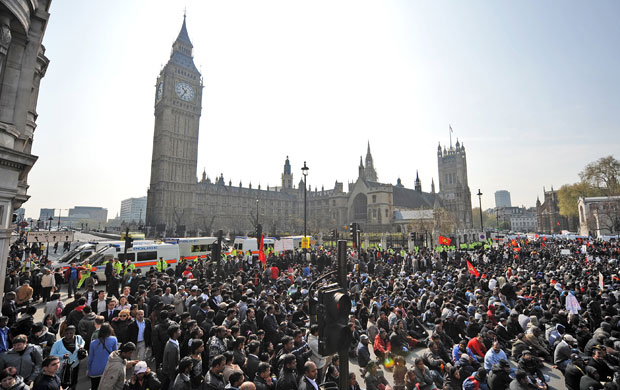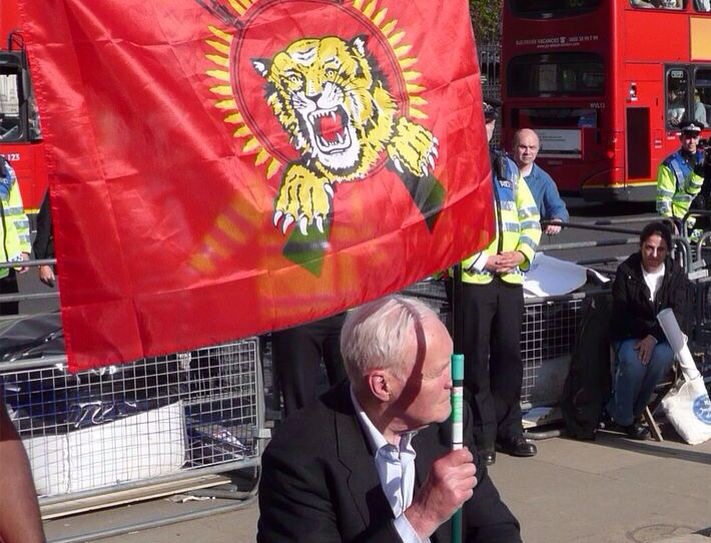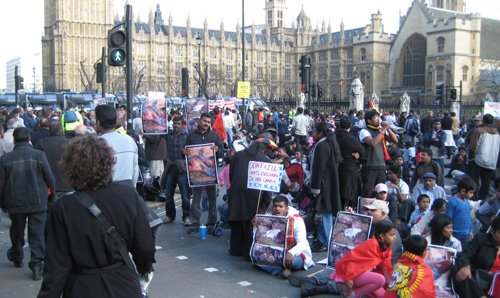10 April 2009 - Stop shelling No Fire Zone, HRW tells Sri Lanka
Human Rights Watch in a press release demanded that the Sri Lankan government stop firing heavy artillery into the ‘No Fire Zone, where they estimated some 100000 Tamil civilians were trapped.
The Asian director at Human Rights Watch described Sri Lanka’s No Fire one as ‘the most dangerous place in the world.’
Reaching out to Human Rights Watch, a doctor in the No Fire Zone, said,
"We have been reporting every day, every day providing reports to relevant authorities and to the international community, and still there are no real steps taken to save these innocent civilians."
See full Human Rights Watch press brief here.
10 April 2009 - US Tamil organisations urge state department to check reports of chemical weapons used in No Fire Zone
Eleven Tamil organisations in a meeting with the US state department urged the US Ambassador to Sri Lanka, Robert Blake, to investigate allegations and evidence of chemical weapon attacks against Tamil civilians and called for aid to be delivered to the No Fire Zone.
See press release from the US state department meeting here.
09 April 2009 - Over 300 injured civilians admitted to Puthumaathalan make shift hospital
Over 300 injured Tamil civilians were admitted to the makeshift hospital with 47 people dying after being admitted throughout the day.
Sources on the ground told Tamilnet that several civilians that were killed by indiscriminate shelling and gunfire by the Sri Lankan military had been left were they lay.
The sources further added that an estimate of the total killed and injured for the day was hard to calculate.
09 April 2009 - ICRC team leader killed in Vanni
A team leader for the International Committee of the Red Cross (ICRC), Sinnathurai Kugathasan, was killed by Sri Lankan military shelling within the No Fire Zone, rescue workers told Tamilnet.
08 April 2009 - Child nutrition centre shelled by Sri Lankan military
411 civilians including 100 children were affected by the shelling of a child care centre and milk powder distribution centre at Pokkanai, within the No Fire Zone.
Reports given to Tamilnet alleged that three artillery shells were fired into the civilian facilities, leaving 129 dead and 100 children injured.
An survivor of the shelling in an eyewitness account to Human Rights Watch, said,
“There had been no distribution of milk powder for three months, and so when they announced that there would be distribution today, hundreds of people lined in queue. It was early in the morning. I heard the first shell, and hit the ground. I survived by miracle, but my 45-year old uncle died on the spot- he lost both legs.”
07 April 2009 - Sri Lankan military uses chemical weapons, says LTTE
A senior commander of the LTTE, who witnessed attacks in the No Fire Zone said that the Sri Lankan Military was extensively using chemical weapons, reported Tamilnet.
The Sri Lankan government had already received criticism for the purchase of weapons banned under international law.
See related article:
Controversial weapon meant for genocide alleges MP (17 August 2001)
07 April 2009 - Shelling starvation and death in the No Fire Zone
A wounded Tamil civilian speaking from the No Fire Zone described the hellish conditions that the people faced under relentless shelling from the Sri Lankan army.
Describing a shell attack that killed his son, the wounded civilian, Subasan, said,
“I was thrown by the blast and both my ears were blocked by the explosion. When I recovered from my initial shock, I realised that I was injured. I tried to save a badly injured 14 year old boy lying nearby but the boy succumbed to his injury.”
“I have two children, but the food we have is inadequate to feed the family. The food we have here is enough for only one person, but we share," he further added speaking to Tamilnet.
6 April 2009 - Thousands of Tamil protestors occupy parliament square demanding international action as slaughter of Tamil civilians in North-East escalates
6 of April marks the 5th anniversary of the parliament square protests. Following 2 weeks of protest outside British parliament the number of demonstrators escalated to thousands in response to the intensified shelling of Tamil civilians in the North-East. Thousands of protestors took to the streets and staged a sit down demonstration in front of the Houses of Commons.
For an eye-witness account of the events see here.
 |
| Thousands of protestors take to the streets |
 |
| Veteran British politician Tony Benn joins demonstrations |
 |
| Photographs: The Guardian |
6th April 2009 - Medical officials in the North-East report systematic shelling of over 250,000 civilians in No Fire Zone
The regional officer of the Mullaitheevu Regional Director of Health Services (RDHS), outlined an obvious pattern of shelling within the No Fire Zone.
The officer reported that conservative estimates placed at least 250,000 people within the No Fire Zone.
5 April 2009 - Sri Lankan Airforce intensifies attack on civilian No Fire Zone
Over 200 civilians were either killed or wounded due to Sri Lankan Air-force bombardment of the No Fire Zone on this day.
Areas of Maaththalan, Pokkanai, Valaignarmadam, Iraddai-vaaykkal and other areas of safety zone were shelled
13th February 2009 - Tamil civilians face intense shelling as they flee to 'No Fire Zones'
Over 150 civilians were feared killed by Sri Lankan Army shelling roads that were being used by civilians to flee from conflict areas and reach newly defined ‘no fire zones.’
Several casualties and fatalities were reported along roads side from Teavipuram to Puthukkudiyiruppu, with the fleeing civilians forced to leave their dead on the side of the roads or bury them under intense shelling.
A further 90 civilians were reported killed by similar circumstances two days prior.
11 February 2009 - Hospitals bombed, relentless assault on Tamil civilians and calls for international protection
February 11th saw the Jaffna Government Agent (GA) made an urgent appeal to international non-governmental organisations to provide food and protection to over 2400 internally displaced people (IDP) that were in held across three Sri Lankan Military run camps.
The LTTE Divisional Political Head in Vanni, C Ilamparithy, whilst rebuffing Sri Lankan military claims that the LTTE were responsible for the slaughtering of civilian, urged the international community to protect Tamil civilians.
The International Committee of the Red Cross (ICRC), in a statement released the previous day, expressed ‘shock’ at the lack of protection and absence of international aid reaching the Tamil population in Vanni.
Speaking at an ICRC press release, the head of the delegation in Sri Lanka, Paul Castella saidgr
“We are shocked that patients are not afforded the protection they are entitled to.”
In a statement LTTE official Ilamparithy said,
“The ‘safety zone’ unilaterally announced by the Colombo government has been turned to a killing field by the Sri Lanka military. The Sri Lankan military machinery, which has relentlessly killed and maimed thousands of civilians during the past four weeks, is now engaged in a propaganda drive to divert mounting pressure on the Colombo government by the international community.”
“Colombo is committing the worst crimes of humanity, by killing and maiming hundreds of civilians every day with the ‘safety zone’ and by indiscriminately bombing medical institutions.”
“The international community must ensure the presence of international protection and the monitoring authorities to assure the safety of the civilians, including the wounded patients and their guardians who accompany them.”
The ICRC press statement also read,
“Most of the population is now displaced and completely depended on outside aid, yet none has reached the area since 29 January.”
In a statement made at the start of the month the ICRC expressed dismay at the Sri Lankan Airforce’s repeated bombing of hospital and medical facilities in Vanni, stating,
“We’re shocked that the hospital was hit, and this for the second time in recent weeks. Wounded and sick people, medical personnel and medical facilities are all protected by international humanitarian law. Under no circumstance may they be directly attacked. The staff are under acute stress surrounded as they are by the sound of ongoing fighting and the influx of new patients. Ambulances are constantly arriving, but people are also being brought in by wagon, pick up trucks, tractor and even motor scooter.”
We need your support
Sri Lanka is one of the most dangerous places in the world to be a journalist. Tamil journalists are particularly at threat, with at least 41 media workers known to have been killed by the Sri Lankan state or its paramilitaries during and after the armed conflict.
Despite the risks, our team on the ground remain committed to providing detailed and accurate reporting of developments in the Tamil homeland, across the island and around the world, as well as providing expert analysis and insight from the Tamil point of view
We need your support in keeping our journalism going. Support our work today.
For more ways to donate visit https://donate.tamilguardian.com.

